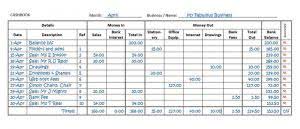
This detailed document offers a comprehensive view of an organization’s expenses, grouped by both function and nature. It serves as a critical tool for financial transparency and accountability, providing stakeholders with valuable insight into how an organization utilizes its resources. The Statement of Functional Expenses provides a detailed breakdown of a nonprofit organization’s financial activities. It includes components such as Program Services, Management and General Expenses, Fundraising Expenses, and Total Expenses.
How Blackbaud’s Software Accounting Solutions Support Nonprofits
For example, a management employee might be spending 30% of her time in fundraising activities but her entire salary has been recorded as management and general expenses. A second issue is whether a donor’s contribution to a nonprofit organization will qualify as a charitable deduction on the donor’s income tax return. For example, churches, schools, and Red Cross chapters are some of the nonprofits that will qualify as tax-exempt and their donors’ contributions will also qualify as charitable deductions on the donors’ income tax returns. The more you leverage these tools, the easier it becomes to generate accurate, relevant financial statements.
- In the non-profit sector, the financial statement has a similar position to a company’s balance sheet.
- Budgeting for nonprofits can become complex when it involves several overlapping categories, such as grants, programs, function, and nature.
- While the statement of cash flows, or cash flow statement, may be a bit difficult to prepare, it is an important financial statement to be read.
- This categorization allows you to reflect how each expense contributes to the nonprofit’s mission and overall operations.
- One works on Program A and another on Program B. You also have a donor outreach manager, an accountant, and a CEO.
Mid-sized health organization
In our last post, Demystifying Nonprofit Overhead, we tackled the concept of “overhead” and why it’s sooooo important for you to understand it. If you use time tracking software to help automate the process, you can easily pull timesheet data from the system. But you can also use it to communicate transparently Cash Flow Management for Small Businesses about spending with donors or to hand over to independent auditors who are evaluating your financial stewardship. While using square footage of office space connects easily to certain expenses like rent, it doesn’t always translate as easily to other types of expenses.
Why Industry Experience Matters (or Doesn’t) When Choosing a Financial Controller
Program expenses are costs related to fulfilling the organization’s mission and programs. These are typically payroll expenses for employees who run the program(s), supplies for the program, and other direct program related activities. An organization can have multiple program categories on the statement of functional expenses.

The headcount method makes sense when allocating expenses like office supplies that are used by everyone in your organization. Especially if your organization is small, allocating these types of expenses by team or department size can help spread these costs over programmatic, fundraising, and management and general classifications. First, let’s detail what a nonprofit statement of financial position, also known as a balance sheet, is. A nonprofit statement of financial position provides an accurate snapshot of the organization’s financial position at a specific time, typically at the end of a fiscal year or quarter. A non-profit balance sheet is similar to the balance sheet used by for-profit businesses; it presents the organization’s assets, liabilities, and net assets (or equity).
So, use bookkeeping the same categories each time you track your expenses to get a clear picture of your spending habits over time. Most importantly, the statement breaks down the expenses into categories based on their function. This blog post demystifies the Statement of Functional Expenses, breaking it down into simple, easy-to-understand terms. Whether you’re a seasoned finance professional, a new nonprofit executive director, or just someone interested in understanding more about how nonprofits manage their finances, this guide is for you.

For funders, this is partially because it’s much more exciting to say that they contributed to, say, helping to feed hungry children. Learn about this important process here, and get tips for creating your own financial statements. Conversely, a statement of activities with natural classification would only list the expense types, such as salaries, utilities, office supplies, and others. A nonprofit statement of activities example will have a heading, body, and bottom line. A multi-column format will be used to present statement of functional expenses the increases and decreases in net assets according to the intent of the donor with column headings for unrestricted, temporarily restricted, and permanently restricted.

Time Studies
Sage makes no representations or warranties of any kind, express or implied, about the completeness or accuracy of this article and related content. Using financial reporting software can help streamline data collection and improve reporting efficiency. Start by gathering all expenses related to programs, administration, and fundraising from your financial records. Administrative costs cover the overall management and daily operations of your nonprofit. It supports budgeting, strategic planning, and resource allocation, allowing nonprofits to optimize spending and make informed decisions. Next, enter your total expenses for each category of natural expenses in the “Total” column.